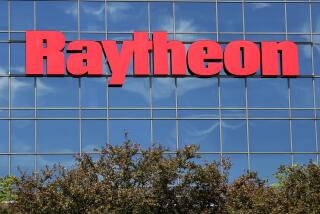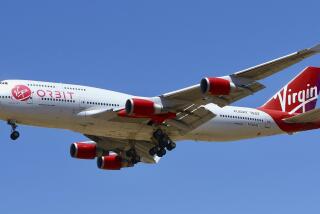Raytheon Selling Key Military Unit to Help Trim Debt
- Share via
NEW YORK — Defense contractor Raytheon Co. said Monday that it will sell its aircraft integration systems business to L-3 Communications Holdings Inc. for $1.13 billion to cut its heavy debt load.
The all-cash transaction rids Raytheon of an underperforming aircraft electronics operation, but one that some Wall Street analysts saw as a “core” business.
For L-3, the deal represents its largest acquisition to date, potentially doubling its annual revenue by one-third for the maker of secure communications networks for the U.S. government and airline black box flight data recorders.
The Aircraft Integration Systems unit “is a national defense asset that for decades has had a special relationship with the U.S. intelligence community,” said L-3 Chief Executive Frank Lanza. “It is a solid company with excellent management, and is in a market niche we know well and serve with our secure communications and electronic products.”
The transaction covers most of Raytheon’s Greenville, Texas-based AIS unit, which modernizes commercial and military aircraft and specializes in advanced avionics as well as surveillance and reconnaissance systems. Raytheon said it will hold on to the Astor program, a $1.3-billion contract with Britain’s Ministry of Defense, awarded in 1999. Astor is an advanced airborne radar surveillance system that provides day, night and all-weather imagery of the ground over a large area.
Shares of both Raytheon and L-3 fell on the New York Stock Exchange. Raytheon lost 34 cents to $31.68 while L-3 dropped 84 cents to $88.17.
“From Raytheon’s perspective, I view it as largely a debt pay-down focus,” said Christopher Mecray, analyst with Deutsche Banc Alex. Brown.
“I do believe it is a core business for them,” Mecray said. “However, it’s a business with a Catch-22 and that is because they have volatile revenue stream and backlog making it difficult to manage.”
The entire aircraft integration systems operation employs more than 6,000 people. The piece being sold to L-3 generated 2001 sales of about $900 million.
Raytheon expects a taxable gain on the sale but an accounting loss due to the amount of goodwill associated with Raytheon’s 1995 acquisition of E-Systems. The L-3 transaction, therefore, should slightly lower 2002 earnings.
Still, the transaction allows Raytheon to shed debt, which it incurred after a spree of acquisitions in the 1990s and stood at $8.8 billion at the end of the third quarter of 2001.
Raytheon said that most of the $1.13 billion in cash from L-3 would be used to reduce debt.
This infusion of cash follows a stock offering in late 2001 that was expected to generate $1 billion, also used to reduce debt.
Raytheon Chief Executive Daniel Burnham said the sale gives it the “financial flexibility and the strategic resources” to focus on areas such as missile defense; precision strike weapons systems; and intelligence, surveillance, and reconnaissance electronics.
L-3 expects the transaction to increase its 2002 diluted earnings per share by 20 cents, after considering the effects of financing the deal.
New York-based L-3, which buys specialized defense businesses, said it expects to offer and sell about $1 billion of debt and equity securities during the first half of this year to retire the interim financing and repay the outstanding balance under a revolving credit facility.
More to Read
Inside the business of entertainment
The Wide Shot brings you news, analysis and insights on everything from streaming wars to production — and what it all means for the future.
You may occasionally receive promotional content from the Los Angeles Times.










